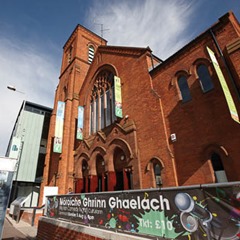Cross-community Irish
 Peter Cheney considers how the Irish language can be promoted as part of culture for both main communities.
Peter Cheney considers how the Irish language can be promoted as part of culture for both main communities.
Debates over language policy often divide opinion on traditional lines but away from the headlines, grassroots movements are expressing the language in ways which seek to reach out across society in a non-political way.
One common misunderstanding is that that language ‘belongs’ exclusively to the Catholic and nationalist community. The 2011 Census does record that
90 per cent of people with some knowledge of Irish were from a Catholic background. However, 7.4 per cent were from a Protestant or other Christian background: 13,715 people.
Presbyterians helped to encourage understanding of Irish in the 19th century while the Church of Ireland’s Irish language guild (Gaelach na hEaglaise) marked its centenary last year.
The Ultach Trust seeks to promote the language across traditional divides. Its Story of Irish (Scéal na Gaeilge) explains that Irish was the dominant language on the island between the 5th and 18th centuries but declined as the official use of English increased and as people moved from country to town during the Industrial Revolution. Following on from the peace process, the trust has seen a significant increase in interest in the Irish language among Protestants and unionists.
Director Aodán Mac Póilin says: “The notion that the Irish language ‘belongs’ to the Catholic nationalist community is very recent. Protestants founded the first revival movement in Belfast in 1828. Seventy-five years later, prominent Orangemen got involved in the Gaelic League. We need to get back to that sense of inclusivity and shared heritage.”
Other cross-community initiatives to help people learn the language include Turas (journey) at the Skainos Centre in East Belfast and the Department of Culture, Arts and Leisure’s Líofa (fluent) campaign.
While the issue of language rights is currently highly political, Northern Ireland’s Gaeltacht movement has entirely non-political roots. Domhnall Mistéal, now an academic, was brought up in Belfast’s Shaws Road Gaeltacht in the 1970s. A group of language enthusiasts set up their own Irish-speaking community in a group of houses which they built themselves. He recalls the experience in his book, Dreamways (Bealach na hAislinge).
Mistéal explains that a group of young men and women with no resources apart from each other “managed to create an environment which promoted language learning, educational achievement and cultural belonging that was independent of any politicised agenda or party allegiance.” He adds: “They built a community with no closed doors, and plenty of open windows.” West Belfast’s Gaeltacht Quarter has subsequently become a springboard for the language with An Cultúrlann being its main hub for music, arts and literature.
While the number of people in Northern Ireland with the most fluent knowledge of Irish – speaking, writing, reading and understanding – is currently decreasing, an increasing number of people have some understanding of the language. Knowledge of Irish stands at 10.7 per cent of all residents aged three and over. This is much higher than the proficiency level for Scots Gaelic in Scotland (1.7 per cent) but lower than that for Welsh in Wales (19 per cent) and for speaking Irish in the Republic (41 per cent).
In terms of policy, the Good Friday Agreement included commitments to promote the language “where appropriate and where people so desire it”. This resulted in a duty on the Department of Education to encourage and facilitate Irish-medium education, the wider broadcasting of Teilifís na Gaeilige, and the formation of Foras na Gaeilge (as a cross-border body to promote the language) in 1999.
An Irish Language Act (Acht na Gaeilge) was proposed in the St Andrews Agreement but was not taken forward during the DUP’s tenure in the Department of Culture, Arts and Leisure. The department passed to Sinn Féin in 2011 and Minister Carál Ní Chuilín published proposals for an Irish Language Bill in February.
A consultation will run up to 5 May but the DUP and UUP have dismissed the proposal as politically motivated.
The Bill would define Irish as an official language and allow for Gaeltacht areas and bilingual road signage. This reflects the approach taken in the Republic’s Official Languages Act 2003 and the Welsh Language Act 1993 which effectively equalise Irish and Welsh with English.
A more flexible approach has been taken in the Gaelic Language (Scotland) Act 2005. This requires a five-year national language plan which is then debated and approved by the Scottish Parliament. The plan is not prescriptive but reflects ministers’ priorities when each one is drawn up and allows for a greater focus on the Highlands and Hebrides where Scots Gaelic is more widely spoken.
While the legislation is unlikely to proceed, Ní Chuilín also published an Irish language strategy (alongside an Ulster-Scots strategy) to develop the language up to 2035. This aims to increase the number of daily speakers of Irish and proposes an academy to protect the language and a right to Irish medium education – which currently enrols 5,000 pupils. DCAL will also seek official recognition for the language in the BBC charter, alongside the existing recognition for Welsh and Scots Gaelic.
The unionist parties remain sceptical, suggesting that any strategy should be based on demand and need rather than rights to particular services.
The census does show a slight increase in demand over the last decade but, as with other policy areas, the finances available to deliver the strategy are becoming increasingly constrained.
The promotion of Irish and Ulster-Scots (combined) will receive £5.6 million in 2015-2016, down from £7 million in 2011-2012.






